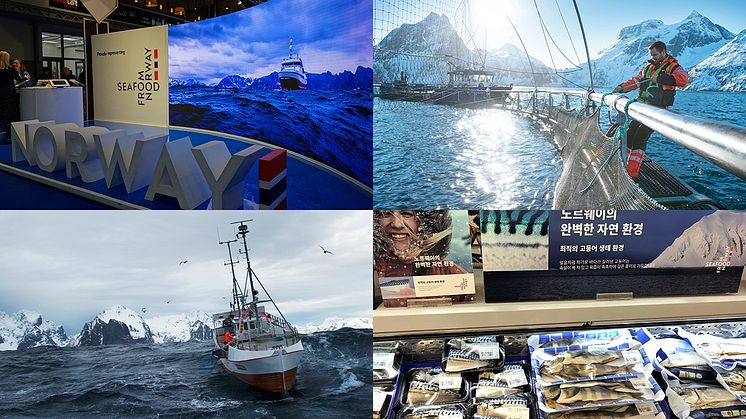
Press release -
Norwegian seafood exports top NOK 107 billion in 2019
Norway exported 2.7 million tonnes of seafood to a total value of NOK 107.3 billion in 2019. This represents a 3 per cent decrease in volume but an 8 per cent (or NOK 8.3 billion) increase in value, compared to 2018, which was a record year. This corresponds to 36 million meals every day throughout the year, or 25,000 meals per minute.
“The Norwegian seafood industry deliver high-quality products that correspond with global trends. Consumers around the world are seeking healthy, sustainable, and tasty food. Norwegian seafood is meeting this demand. Both the aquaculture and fisheries sectors have been instrumental in reaching record-level export value in 2019”, says Renate Larsen, CEO of the Norwegian Seafood Council.
“In addition to a weak Norwegian krone and improved market access, we have seen a rise in prices for several of our most important commercial species. In sum, this has led to strong demand and higher prices for Norwegian seafood,” says Tom-Jørgen Gangsø, Director of Market Insight and Market Access at the Norwegian Seafood Council.
The relationship between aquaculture and fisheries has changed little from last year. Aquaculture represents 71 per cent by value, and 44.6 per cent by volume.
In 2019, Norway exported 1.2 million tonnes of fish from aquaculture worth NOK 76.5 billion. Volume has increased by 7 per cent, while the export value has increased by NOK 5.6 billion or 8 per cent compared to 2018.
Fisheries account for 29 per cent of total seafood exports measured by value. Measured by volume, fisheries account for 55.4 per cent.
For fisheries, export volume totaled 1.5 million tonnes, worth NOK 30.8 billion. This is a 10 per cent reduction in volume, but a 10 per cent or NOK 2.7 million year-on-year increase in value.
The largest species
Salmon is by far the largest species both in terms of volume and value. Salmon exports in 2019 amounted to 1.1 million tonnes, representing NOK 72.5 billion in export value. Export volume increased by 6 per cent, and export value increased by 7 per cent or NOK 4.8 billion from 2018.
“The weakening of the Norwegian kroner and increased demand for Norwegian salmon are the two main reasons for the increase in value 2019”, says Paul T. Aandahl, Seafood Analyst with the Norwegian Seafood Council.
2019 has seen a significant increase in the trade of seafood between Norway and China.
"2019 was the year where Norwegian salmon made its comeback in the Chinese market. Throughout the year, market access has bettered terms for Norwegian players with interest in the Chinese market. We expect the positive trend to continue for 2020, says Victoria Braathen with the Norwegian Seafood Council in China.
Trout is the second major fish species. 59,600 tonnes of trout were exported with a value of NOK 3.7 billion. Volume increased by 29 per cent while export value increased by NOK 707 million or 24 per cent compared to 2018.
“Generally, we see that trout prices follow salmon prices. That is why the price of trout remained at almost the same level as in 2018, despite a relatively large growth in export volume”, says Aandahl.
For the fisheries sector, cod is the largest species measured in terms of value. Cod exports in 2019 totalled 181,000 tonnes, and NOK 10.1 billion by value. Export volume fell by 8 per cent, while value increased by NOK 660 million or 7 per cent compared to 2018.
“The decline in export volumes for cod is due to reduced quotas since the peak year for cod in 2013. A significant rise in prices for all the major cod products is therefore an important reason for the growth in value. The fall in volume, ably assisted by a weak Norwegian kroner coupled with growth in demand, explains the price increase”, says Ingrid K. Pettersen, Seafood Analyst with the Norwegian Seafood Council.
"There as been a significant increase in the demand for cod frozen at sea, here in the UK, throughout the year. There is also a clear willingness to pay more for the quality that Norwegian exporters offer", says Hans Frode Kielland Asmyhr, with the Norwegian Seafood Council in UK.
Mackerel is the second largest species in the catch sector. Export volumes for mackerel in 2019 were 238,000 tonnes, and export value totalled NOK 4.3 billion. Export volume in 2019 fell 7 per cent, while the value increased by NOK 464 million or 12 per cent compared to 2018.
“The increase in value is mainly due to an increase in the price of mackerel purchased in foreign currency, in addition to a weakening of the Norwegian kroner. Expectations for lower available volume in 2019 have probably also helped to increase the price of mackerel”, says Frank Isaksen, Seafood Analyst at the Norwegian Seafood Council.
“Japan is an important market for Norwegian mackerel exports. Measured in Japanese Yen, the price increased slightly from 2018, and combined with the relatively sharp depreciation of the Norwegian krone, has resulted in a solid rise in prices when measured in Norwegian kroner”, says Isaksen.
In 2019, Norwegian mackerel bolstered its position in the main markets, Japan and South Korea.
"In markets with growing competition, increased media coverage and use of the origin mark has been important factors to fortify Norwegian mackerel as a high quality product, says Gunvar L. Wie, NSC director for Japan and South Korea.
In 2019, 349,000 tonnes of herring were exported, worth NOK 3.2 billion. Volume increased by 20 per cent, while export value increased by NOK 541 million or 21 per cent.
“2019 saw slightly lower average prices measured in US dollars during the periods of peak catches”, says Isaksen.
Saithe is the second largest species of whitefish in terms of export performance. Exports of saithe in 2019 were 116,000 tonnes, while the value was NOK 2.5 billion. Volume increased by 9 per cent while value increased by NOK 373 million or 18 per cent from 2018.
Haddock is our third most significant whitefish export. Exports of haddock in 2019 amounted to 60,100 tonnes, while the export value totalled was NOK 1.8 billion. Volume fell by 2 per cent while the value increased by NOK 77 million or 5 per cent compared to 2018.
Prawns is our most important shellfish species for export. Exports of prawns in 2019 were 16,100 tonnes and NOK 1.1 billion in value. Volume was up 50 per cent while export value increased by NOK 255 million or 31 per cent against 2018.
“There has been a big increase in the catch of prawns in the Barents Sea this year, and this has probably contributed to putting some pressure on prices. Other countries than Norway have contributed most to the increases in prawns supply. Prices in 2019 measured in EUR have been somewhat lower than the previous year, and there has also been a price decline when measured in Norwegian kroner”, says Frank Isaksen.
King crab is our second most valuable shellfish species. King crab exports in 2019 were 2,000 tonnes, and NOK 642 million by value. Volume increased by 3 per cent while value increased by NOK 64 million or 11 per cent measured against 2018.
“There have been relatively stable prices measured in US dollars for king crab, and the value increase is largely due to a weaker Norwegian krone”, says Frank Isaksen.
“There have also been relatively stable prices of snow crab exports measured in US dollars. There has been an increase in the export of snow crabs in 2019, and increased profitability is reported by industry. The increased profitability bodes well for further investment in this species”, says Isaksen.
Processed products
Export of clipfish in 2019 totalled 91,800 tonnes, and NOK 4.8 million by value. Volume was at the same level as during 2018, but the export value increased by NOK 529 million or 12 per cent against 2018.
“The low export levels of whole salted fish, together with a good development in the Portuguese market, explains the high value growth for codfish, especially in the second half of 2019”, says Ingrid K. Pettersen, Seafood Analyst at the Norwegian Seafood Council.
The export of salted fish in 2019 totalled 23,400 tonnes, while the value was NOK 1.3 billion. Volume fell by 19 per cent while export value fell by NOK 147 million or 10 per cent against 2018.
“Less available raw material and high raw material prices explain why export of salted fish has declined in 2019. The high salted fish prices probably led some of the Portuguese clipfish producers to hesitate to buy Norwegian”, says Ingrid K. Pettersen.
Exports of stockfish in 2019 were 5,600 tonnes, while the value was NOK 822 million. Volume fell by 24 per cent while value increased by NOK 67 million or 9 per cent by 2018.
“After several years of falling exports of stockfish to Italy, there has been an increase in the volume of exports to Italy, even at historically high prices. At the same time, the demand for dried cod heads in Nigeria also contributes significantly” (?), says Pettersen.
The largest markets for Norwegian seafood
Norwegian seafood producers exported 1.6 million tonnes of seafood to the EU worth NOK 68 billion. This represents a 7 per cent increase in volume, and a NOK 2.4 billion, or 4 per cent, increase in export value compared to 2018.
In 2019, 506,000 tonnes of seafood worth NOK 21.4 billion were exported to Asia. This is a 6 per cent growth in volume and a NOK 3.7 billion or 21 per increase in value from 2018.
To Eastern Europe, the export volume was 168,000 tonnes while the export value ended the year at NOK 4.3 billion. This represents a decrease of 2 per cent, but an increase in value of NOK 676 million or 19 per cent year-on-year.
Poland remains our largest market in terms of export value. 230,000 tonnes of seafood were exported, totalling NOK 10.6 billion. 2019 saw an increase of 1 per cent by volume and an increase of NOK 407 million or 4 per cent by value.
Denmark is now the second largest market for Norwegian seafood in terms of export value. Norway exported seafood to Denmark with a total value of NOK 9.2 billion in 2019. This is an increase of NOK 660 million or 8 per cent compared to the previous year. The largest growth market outside Poland in 2019 was China which has grown by as much as NOK 1.5 billion or 40 per cent finishing the year with a total export value of NOK 5.2 billion. This makes China our 7th most important market in 2019.
The value of sustainability – export value could potentially double by 2030
“Particularly among the younger population we see an increasing trend were climate, environment and health are increasingly important. Consequently, there is an increasing willingness to pay for sustainable food in most markets”, says Renate Larsen, CEO of the Norwegian Seafood Council.
“Our research and seafood studies show that consumers all over the world already perceive Norwegian seafood as safe, sustainable and of high quality. If we are able to position Norwegian seafood’s position as the most sustainable option, our calculations indicate that the export value can potentially double in the next decade, reaching NOK 200 billion”, says Renate Larsen, CEO of the Norwegian Seafood Council.
Topics
Categories
The Norwegian Seafood Council works with the Norwegian fisheries and aquaculture industries to develop markets for Norwegian seafood through local market intelligence, market development and reputational risk management. The Seafood Council is headquartered in Tromsø and maintains local representatives in twelve of Norway's most important international markets. The Norwegian seafood industry finances the activities of the Norwegian Seafood Council via a tariff on all Norwegian seafood exports.
The Norwegian Seafood Council is a public company owned by the Ministry of Trade, Industry and Fisheries.

